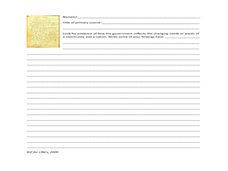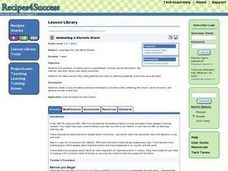Curated OER
Royal Proclamation on Education: King Chulalongkorn of Siam
How much did the King of Siam value education? Why did he believe haste was important? How do his views compare with modern views of education? These are the questions your class will answer after reading an excerpt from the "Royal...
Idaho State Department of Education
Lessons for Social Studies Educators
Point of view, purpose, and tone: three concepts readers of primary and secondary source materials must take into account when examining documents. Class members view a PowerPoint presentation and use the SOAPS strategy to identify an...
Curated OER
Dispute Over Slavery in Kansas Territory
Students analyze primary sources on slavery from Kansas Territory. In this Civil War lesson, students evaluate the antislavery and pro-slavery arguments and summarize key points. Students write a persuasive paper from the antislavery...
Curated OER
Towards Separation of Church and State in Gloucester
Explore New England government in the 1700's with your class. They will identify historical documents as primary or secondary sources, then read and discuss the significance of these documents as they relate to the "freedom of religion"...
Mr. Roughton
Cold Case Rome
Pupils are transformed into detectives in the case to solve the motive behind the assassination of Julius Caesar. This resource includes eight engaging "exhibits" of unique primary and secondary sources for students to analyze during...
Mr. Roughton
CSI: Florence
Who done it? Class groups adopt the role of crime scene investigators and examine exhibits (primary source documents) to determine who attempted to assassinate the members of the Medici dynasty.
Curated OER
Compare Present Day Photographs to Historical Photographs from the Museum's Collection
Eighth graders discuss photojournalism and then compare present day to historical photographs. They discuss how photos capture daily life and historical events, compare historic photos to those seen today, then take and make a photo book...
Roy Rosenzweig Center for History and New Media
European Explorers
To compare how the Spanish, French, and English approached the exploration of North America, class groups examine primary source documents and become experts on one of four explorers: Francisco Coronado, Robert LaSalle, Samuel de...
Curated OER
Primary vs. Secondary Sources Notes
What’s the difference between primary and secondary source materials? Here’s a handout, designed as a reference for learners, that does a good job of distinguishing between primary and secondary source materials and providing examples of...
Curated OER
The Crittenden Conway Duel
Young scholars explore primary and secondary sources. In this primary and secondary source activity, students investigate a crime scene. Young scholars search for evidence around the classroom and evaluate their findings. Students write...
Curated OER
Found Poetry with Primary Sources: The Great Depression
Students read a sample found poem and create one together as a class. In this Great Depression lesson, students select a topic, such as miners, and read primary source documents related to the topic. Students select one narrative as the...
Canadian War Museum
Comparing Primary and Secondary Sources
This simple two-day lesson introduces learners to the differences between primary and secondary sources. The lesson includes group work that explores the similarities and differences, and the advantages and disadvantages of primary and...
EngageNY
Gathering Textual Evidence: “Invisibility” of Those Interned
Add another layer to the class's understanding. Scholars deepen their knowledge of the primary sources in their Japanese-American Internment during World War II packet and determine how the sources relate to the theme of invisibility....
Foreign Policy Research Institute
Comparing Regimes: Critical Reading of Memoirs and Experiences from Totalitarian Regimes
Can you imagine living in a totalitarian country? Learners will read several primary source memoirs to gain a deeper understanding of what life is like under a controlled government. They'll discuss each piece in pairs, research...
PBS
March on Washington: A Time for Change
Young historians conclude their study of the events that lead up to and the planning for the March on Washington. After examining videos and primary source documents, they consider the civil rights objectives that still need to be...
Albert Shanker Institute
The March on Washington Logistics Then and Now
I have a dream ... that all pupils will be able to organize a march of their own after learning about how Bayard Rustin organized the 1963 March on Washington for civil rights. Young reformers work collaboratively examining informational...
Curated OER
Unit 1: Water is Life: The Heart and Science Behind this Phrase
Water, water, everywhere — but will there be enough to drink? Check out these detailed lesson plans to meet NGSS water cycle and CCSS literacy standards in your science classroom. Learners do a close reading of a challenging, poetic text...
Curated OER
A Soldier's View of the American Civil War
Study and research the American Civil War in this explanatory writing instructional activity. Middle schoolers complete six activities to learn about the American Civil War and soldiers' views of the war. The instructional activity...
Curated OER
Reporting on the 1920s
Use this roaring 1920s history lesson to have young writers research primary and secondary sources. They use their research to examine the events or famous public figures of the time period. Next, they imagine they're in the 1920s and...
Curated OER
West Indies and The Caribbean: Sugar & Slavery
Students study the state of the world before the slave trade. They explain the geography and economics of the slave trade. They explore primary sources and how historians use these sources to create historical interpretations.
Curated OER
Animating a Historic Event
Research a historic event using textbooks, primary source documents, the Internet, and other library and media resources. Young historians will take the research they have gathered and write an attention-grabbing, historically accurate...
Curated OER
Congress and the Creation of the Bill of Rights
Students participate in inquiry activities to explore powers outlined in the Bill of Rights. In this Bill of Rights lesson plan, students creation of a class Bill of Rights, evaluate and propose amendments, and analyze primary source...
Curated OER
Personal Stories of the National Parks
Students explore historical information about U.S. national parks using the stories of Edward and Margaret Gehrke as a primary source document. In this United States geography, history, and literacy lesson, students view the diary...
National Park Service
A Tale of Two Men
Theodore Roosevelt and the Marquis de Mores were both born in 1858, and both came to the Dakota territory in 1883, but they influenced the developing country of America in different ways. Elementary and middle schoolers apply written and...
Other popular searches
- Using Primary Sources
- Wwi, Primary Sources
- Rosa Parks Primary Documents
- Gilded Age Primary Sources
- Working With Primary Sources
- Primary Resources Hsie
- Web Quests Primary Sources
- Ancient Rome Primary Sources
- 1920 1929 Primary Sources
- Primary Sources and Family
- Conscription Primary Sources
- Scotland Primary Sources

























